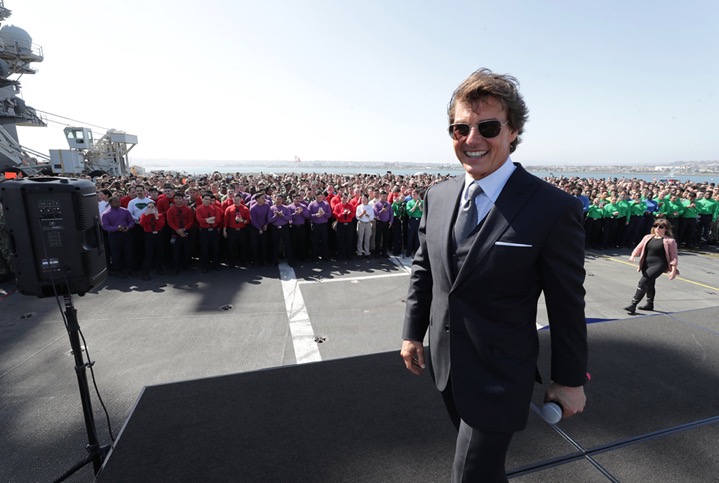CommentsCONNECTING CALIFORNIA - Watching Top Gun: Maverick made me feel sad—for San Diego.
San Franciscans have Alfred Hitchcock’s Vertigo, a classic film of cinematic heights and existential falls, to define their city by the bay. Los Angeles explains its fundamental fatalism about corruption and power through Roman Polanski’s nasty noir Chinatown.
But San Diego—a beautiful place full of people who have thought and fought for their country—has long had to settle for 1986’s Top Gun, a dumb, jingoistic, and misogynistic Tom Cruise vehicle about Naval aviators, as its cinematic signature. Sure, San Diego played other places in acclaimed films from Some Like It Hot to Citizen Kane (the latter filmed in the city’s Balboa Park). But when it comes to playing and expressing itself, San Diego’s stuck with Top Gun and the 2004 comedy Anchorman, about dumb and misogynistic local TV personalities.
The arrival of a Top Gun sequel—after 36 years—certainly doesn’t solve the problem, even if it is a box office hit. This ludicrous film mirrors American decline, while misrepresenting San Diego in the process.
Top Gun: Maverick is premised entirely on an error of fact, pretending that the eponymous school for Navy fighter pilots operates out of the North Island Naval Air Station.
But the real-life Topgun was relocated from San Diego’s Miramar Naval Air Station to Fallon, Nevada back in 1996, as part of post-Cold War defense consolidation.
It’s not coming back.
Except in the movies—because a vapid and predictable film wants to tap into the magic of San Diego.
Part of that magic lies in the city’s beauty. So, the movie transports audiences not just to the naval base on North Island, but to Point Loma, various parts of Coronado, and Fort Rosecrans National Cemetery. And we also get the tourism-bureau-approved privilege of watching Jennifer Connelly and Tom Cruise sail across the bay.
Another piece of that magic is San Diego’s image as protector of America. San Diego is California’s most American city, a striking contrast to Los Angeles and San Francisco, which see themselves as global metropolises, proudly out of step with the rest of the United States.
While other Californians debate whether to stand for national anthem at all, San Diegans sing the song themselves, often while flying the flag outside their front door. And the longstanding presence of the military provides the city with a deep well of patriotic renewal.
Top Gun: Maverick seeks to mine this well, but ultimately undermines it. When the movie taps into San Diego’s patriotism, it does the city a disservice.
While the original Top Gun was full of memorable, funny one-liners (“I feel the need, the need for speed” and “No points for second place”), the sequel decides to champion the line, “Don’t think—just do.”
The phrase isn’t just clunky. It reads as an indictment of both the film’s idiotic denouement (a Star Wars rip-off, with jets flying through a steep canyon to get off a miracle shot in the climactic moment) and of the United States itself.
“Don’t think” all too perfectly describes a country that thoughtlessly fails to vaccinate or wear masks—and ends up with more than one million people dead from COVID, apparently the highest death tally in the world. “Don’t think” fits an America that responds to gun violence by loosening restrictions on guns, making mass shootings routine. “Don’t think—just do” mirrors the American foreign policy that has kept us at war, in one place or another, for decades.
Pity San Diego, or any place else with a mission of defending such a country. Because so much of the time, to defend America is to defend the indefensible.
Which is why the movie is so unfair to San Diego. While military and aerospace are still highly visible in San Diego, the place is hardly dominated by these industries.
And San Diego actually does quite a lot of thinking.
In the original Top Gun, Cruise’s love interest was a mathematician with a PhD who worked for the Department of Defense; in the sequel, his love interest owns a bar. But San Diego, unlike Cruise’s cinematic partners, has become smarter over the past generation. It’s one of the country’s most educated cities, by measures that combine college degree attainment with the quality of its schools. It’s a leader in inventing new health and medical devices. Its remaining military installations are deeply grounded in science and tech. It’s a force in trade. And it just opened a new trolley line to its leading university, UC San Diego.
The film ignores this context, instead projecting its idiocy onto the city.
That’s too bad. San Diego deserves a cinematic touchstone as smart as it is.
(Joe Mathews writes the Connecting California column for Zócalo Public Square where this article was first published.)






